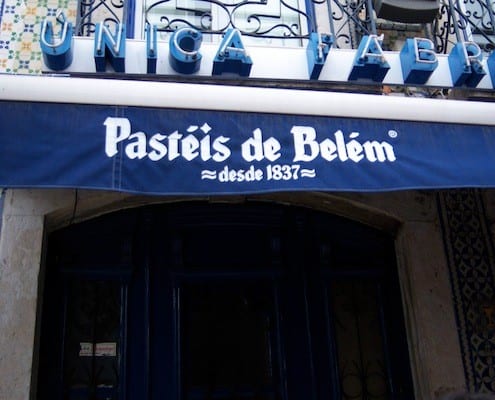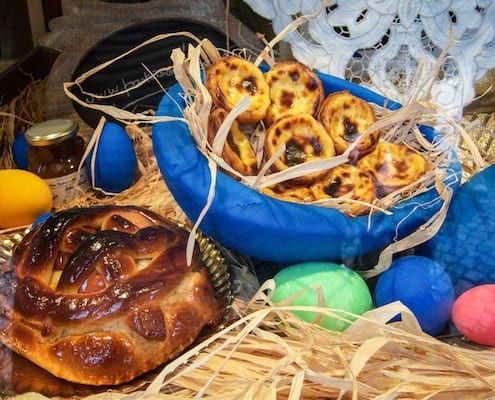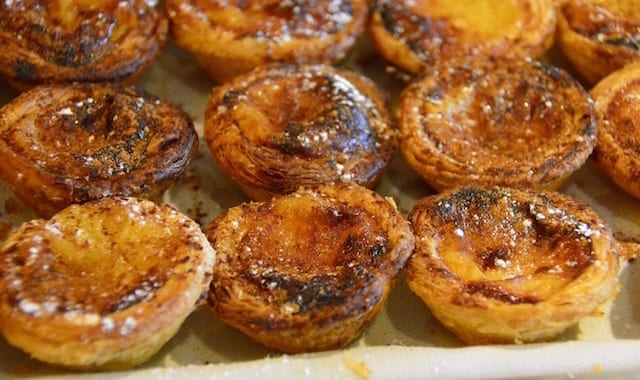Carolyng loves to eat, loves to cook and loves to…
Pastéis de Belém makes pastéis exactly as they were done almost 200 hundred years ago.
Carolyng Gomes
On my latest trip to Portugal I vowed to myself, and my family, that my visit wasn’t just fun and games. I would be doing a lot of research… for work. What did I do to complete my research? I stepped into every bakery, pasteleira, grocery store and open market for a glimpse (and taste) of their culinary offerings, focusing closely on all things sweet, savory and in pastry form. I thought I was in heaven, since almost every block in Lisbon has a few of these establishments to choose from, each with its own specialties, and each as extraordinarily delicious as the last. I didn’t think it could get any better until I ventured farther out and arrived at the quiet town of Belém.
 Belém is known today for its tourist attractions, which include the Mosteiro dos Jerónimos, the Torre de Belém and the museums that accompany them. However, the attraction that trumps them all and keeps the tourists and the locals coming back for more is Beléms world-renowned bakery, Pastéis de Belém. Here you will find an abundance of sweet treats, but none compare to their most famous confection aptly called pastéis de Belém.
Belém is known today for its tourist attractions, which include the Mosteiro dos Jerónimos, the Torre de Belém and the museums that accompany them. However, the attraction that trumps them all and keeps the tourists and the locals coming back for more is Beléms world-renowned bakery, Pastéis de Belém. Here you will find an abundance of sweet treats, but none compare to their most famous confection aptly called pastéis de Belém.
These pastéis, known as the best nata’s you will ever taste, are comprised of a delicate, crisp shell made from massa folhada, similar to phylo dough, and are filled with a luscious, silky smooth and slightly sweetened egg custard that is best enjoyed warm with 6 more in a to-go box. Though to-go doesn’t mean they will make it out the front door, they rarely do, it is best to order more than you plan on eating. You can never eat just one of these desserts, whose rich taste is only rivaled by its rich history.
It isn’t until the beginning of the 19th century, when the 1820 liberal revolution shut down all of the convents and monasteries in Portugal, that our story begins. Those individuals that were not expelled from the area began selling pastries from the monastery, and the traditional recipe that originated with the nuns of the Mosterio dos Jerónimos was bought by Domingo Rafael Alves, a business man that started producing the pastéis in 1837 from his shop close by.
This shop, today known as Pastéis de Belém, Pastries of Belém, makes the pastéis exactly as they were done almost 200 hundred years ago. The recipe continues to be a well-guarded secret, with only a handful of people closely linked to the Alves family and the bakery possessing the complete recipe. The custard and dough is even made behind locked doors, just to ensure no snooping eyes (mine included) get a sneak peak at the goods. In 1911 they even got the name “Pastéis de Belém” registered so customers would know when they were getting authentic Pastéis de Belém. Other versions of this custard based dessert are often referred to as pastéis de nata or nata’s.
Either way, attempting to recreate this dish is a challenge that I will take on but know will end in a delicious, valiant effort that will have no comparison to the original. These pastéis are iconic, full of history, tradition and secrecy that just can’t be recreated in any kitchen. Unfortunately I can’t get to Pastéis de Belém when I get that craving for a warm sweet treat, and when I can rest assured I will savor those decadent desserts until I explode… but until then I will have to settle for Pastéis de Casa Gomes.
Pastéis de Belém is full of mystery, intrigue and adventure, a combination that cannot be recreated just enjoyed and appreciated. Next time you are in Portugal make sure you visit this historic landmark on an empty stomach. You will not be disappointed.
Pastéis de Belém
Rua de Belem, 84
1300-085, Lisboa, Portugal
Carolyng loves to eat, loves to cook and loves to eat more. To her a recipe is more a list of suggestions, saving time doesn’t mean sacrificing on flavor and when in doubt, a splash or two (well, a nice pour) of wine never hurts. Welcome to her Cocina Latina, where South American and Latin fusion dishes are always on the menu.






My sister lived in Portugal for 3 years. No visit was complete without a visit to Pastéis de Belém. Thanks for taking me back.
Cheri,
It is an amazing place and I must say it was incredible to visit and (over)indulge in those deliciously decadent pasteis.
Stay tuned for a recipe and article I will be adding soon to Cocina Latina for homemade natas :)
I’ve been meaning to try to make these for a long time. really like this article!